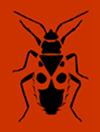Infection-induced molecular pattern recognition proteins in larvae of Protaetia brevitarsis seulensis (Coleoptera: Cetoniidae)
IF 1.2
3区 农林科学
Q2 Agricultural and Biological Sciences
引用次数: 1
Abstract
We cloned and sequenced full-length peptidoglycan recognition protein (PGRP)-like cDNAs, named PS PGRP-SA(a)like, PS PGRP-SA(b)-like, PS PGRP-SB1-like and PS PGRP-SC-like, from Protaetia brevitarsis seulensis. The amino acid sequences of PS PGRPs share 32.03−47.93% homology with those of PGRP family members in insects and mammals, including humans. We identified a conserved consensus sequence for amidase activity (His; H-Tyr; Y-His; H-Thr; T-Cys; C) and residues for binding peptidoglycan (PGN), one of the major bacterial cell wall components, including Asp (D) and Phe (F) for Lys-type PGN; and Gly(G), Trp (W) and Arg (R) for DAP-type PGN. The topological structures of PS PGRP-SA(a)-like, PS PGRP-SA(b)-like and PS PGRP-SC-like proteins are structurally similar to those of Drosophila melanogaster PGRP-SA, which has three α-helices and six β-strands. The β-strands are located in a central region and helix α1 on the back and peripheral α2 and α3 helices are on the front. The three α-helices and six β-strands are also present in PS PGRP-SB1-like, but the topological structure differs from that of typical PGRP. Significantly increased levels of PS PGRP-SA (a)-like and PS PGRP-SA (b)-like mRNA were recorded when Gram-positive bacteria or yeast cells were injected into larvae. PS PGRP-SB1-like mRNA levels were up-regulated by infection by all three pathogens; however, expression of PS PGRP-SC-like mRNA was increased 20or 30-fold only shortly after injection with Gram-negative bacteria. * Corresponding author; e-mail: saeyoullcho@kangwon.ac.kr InTroDUCTIon Micro-associated molecular patterns (MAMPs) and pathogen-associated molecular patterns (PAMPs), such as peptidoglycan (PGN), lipopolysaccharide (LPS), β-glucans, lipoproteins, CpG dinucleotides and flagellin, are molecular markers recognized by the insect innate immune system. There are various cellular immune responses of insect blood cells (haemocytes) and humoral immune responses mediated by various effector molecules, including antimicrobial peptides (AMPs) and the phenol oxidase (PO) cascade is part of the insect immune system (Janeway et al., 2002; Hoffmann, 2003; Cho & Cho, 2019). Humoral immune responses involving Toll and immune deficiency (IMD) pathways are mainly activated by insect pattern recognition receptors (PRRs) (Wang et al., 2019). Therefore, humoral immune responses are activated when MAMPs are recognized by insect PRRs. Peptidoglycan recognition proteins (PGRPs), C-type lectin receptors (CLRs), fibrinogen-related proteins (FREPs), thioester-containing proEur. J. Entomol. 119: 77–84, 2022 doi: 10.14411/eje.2022.008短视原蜂幼虫感染诱导的分子模式识别蛋白研究(鞘翅目:拟蜂科)
我们克隆并测序了从短须鲸中提取的全长肽聚糖识别蛋白(PGRP)样cdna,分别命名为PS PGRP- sa (a)like、PS PGRP- sa (b) like、PS PGRP- sb1 like和PS PGRP- sc like。与昆虫和哺乳动物(包括人类)PGRP家族成员的氨基酸序列同源性为32.03−47.93%。我们确定了一个保守的酰胺酶活性一致序列(His;H-Tyr;他;H-Thr;T-Cys;C)和结合细菌细胞壁主要成分之一肽聚糖(PGN)的残基,包括lystype PGN的Asp (D)和Phe (F);Gly(G)、Trp (W)、Arg (R)表示dap型PGN。PS PGRP-SA(a) like、PS PGRP-SA(b) like和PS PGRP-SC-like蛋白的拓扑结构与果蝇PGRP-SA结构相似,具有3个α-螺旋和6个β-链。β-链位于中心区域,α1螺旋位于后面,α2和α3螺旋位于前面。3个α-螺旋和6个β-链也存在于PS PGRP- sb1中,但其拓扑结构与典型的PGRP不同。革兰氏阳性菌或酵母细胞注射后,幼虫体内PS PGRP-SA (a)样和PS PGRP-SA (b)样mRNA水平均显著升高。三种病原菌感染后,pgrp - sb1样mRNA水平均上调;然而,注射革兰氏阴性菌后不久,PS pgrp - sc样mRNA的表达增加了20或30倍。*通讯作者;微相关分子模式(MAMPs)和病原体相关分子模式(PAMPs),如肽聚糖(PGN)、脂多糖(LPS)、β-葡聚糖、脂蛋白、CpG二核苷酸和鞭毛蛋白等,是昆虫先天免疫系统识别的分子标记。昆虫血细胞(血细胞)有各种细胞免疫反应,体液免疫反应由各种效应分子介导,包括抗菌肽(AMPs)和酚氧化酶(PO)级联是昆虫免疫系统的一部分(Janeway等,2002;霍夫曼,2003;Cho & Cho, 2019)。涉及Toll和免疫缺陷(IMD)途径的体液免疫反应主要由昆虫模式识别受体(PRRs)激活(Wang et al., 2019)。因此,当MAMPs被昆虫PRRs识别时,体液免疫反应被激活。肽聚糖识别蛋白(PGRPs), c型凝集素受体(CLRs),纤维蛋白原相关蛋白(FREPs),含硫酯proEur。[j] .中国生物医学工程学报,2016,33 (2):444 - 444
本文章由计算机程序翻译,如有差异,请以英文原文为准。
求助全文
约1分钟内获得全文
求助全文
来源期刊
CiteScore
2.30
自引率
7.70%
发文量
43
审稿时长
6-12 weeks
期刊介绍:
EJE publishes original articles, reviews and points of view on all aspects of entomology. There are no restrictions on geographic region or taxon (Myriapoda, Chelicerata and terrestrial Crustacea included). Comprehensive studies and comparative/experimental approaches are preferred and the following types of manuscripts will usually be declined:
- Descriptive alpha-taxonomic studies unless the paper is markedly comprehensive/revisional taxonomically or regionally, and/or significantly improves our knowledge of comparative morphology, relationships or biogeography of the higher taxon concerned;
- Other purely or predominantly descriptive or enumerative papers [such as (ultra)structural and functional details, life tables, host records, distributional records and faunistic surveys, compiled checklists, etc.] unless they are exceptionally comprehensive or concern data or taxa of particular entomological (e.g., phylogenetic) interest;
- Papers evaluating the effect of chemicals (including pesticides, plant extracts, attractants or repellents, etc.), irradiation, pathogens, or dealing with other data of predominantly agro-economic impact without general entomological relevance.

 求助内容:
求助内容: 应助结果提醒方式:
应助结果提醒方式:


